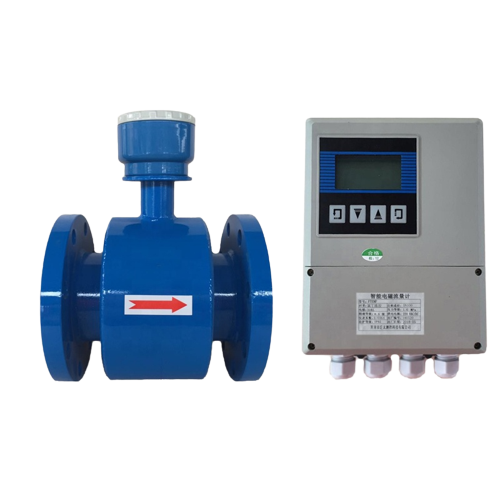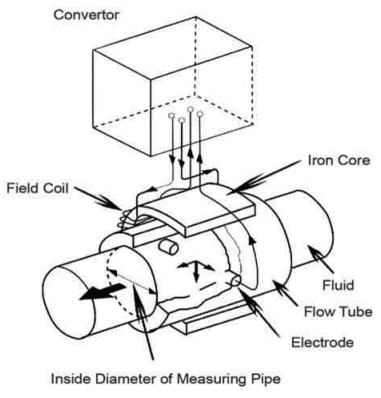Electromagnetic water Flow Meter
ELECTROMAGNETIC FLOW METER
Electromagnetic flow meters (also called mag meters, electromag meters, or magnetic flow meters), are volumetric flow meters that use electromagnetic induction to measure liquid velocity. This method of measurement is highly accurate at measuring water-based fluids as they pass through a pipe.
Electromagnetic flow meters feature an obstruction-free design which eliminates flow impediments and operate with electrodes embedded on opposite sides of the flow tube or sensor to pick up the signal. Mag meters perform extremely well in many municipal and processing applications and have become the meter of choice for measuring conductive liquids such as water or slurry.

Working principle of electromagnetic flow meter
The working princple is based on Faradays Law of Electromagnetic Induction, that is, when the conductive liquid flows though the electromagnet flowmeter the duced comotive force w be produced in the conductor, and the induced elecom force is diectly poona to the velocity of conductive liquid magnetic flux density and with of conductor(inside diameter of flowmeter)
Such induced electromotive force is detected by a pair of electrodes on the tube wall of the flowmeter, and the rate of flow can be acquired by mathematical operation The quation of nduced electromotive force is as follows:
E = D · V · B
E: induced electromotive force
D: inside diameter of measuring pipe
V: velocity
B: magnetic flux density
The following conditions should be satisfied in order to obtain satisfactory measuring accuracy.
- The tested liquid shall possess the electrical conductivity
- The pipe shall be full of liquid
- The components of liquid shall be well mixed
- If the liquid has magnetic permeability, the magnetic field of the flowmeter will change, so the flowmeter shall be modified

Do not install the meter near equipment that produces electrical interference such as electric motors, transformers, variable frequency, power cables etc.
Avoid locations with pipe vibrations for example pumps.
Do not install the meter close to pipeline valves, fittings or impediments which can cause flow disturbances.
Place the meter where there is enough access for installation and maintenance tasks.
lnstall at the lowest point and vertical upward direction Don’t install at the highest point or vertical downward diection |
When drop is more than 5m, install exhaust valve at the downstream |
lnstall at the lowest point when used in open drain pipe |
Need 10D of upstream and 5D of downstream |
Dont’ install it at the entrance of pump, install it at the exit of pump |
lnstall at the rising direction |
1. Introduction:
Flow measurement is critical in numerous industries, such as water and wastewater treatment, chemical processing, oil and gas, food and beverage, and more. Accurate flow data allows operators to monitor processes, optimize efficiency, and ensure compliance with regulatory standards. Electromagnetic flow meters have emerged as one of the most reliable and widely used instruments for fluid flow measurement. This article delves into the various aspects of electromagnetic flow meter, providing a comprehensive overview for readers.
2. Working Principles:
The operating principles of electromagnetic flow meters are founded on Faraday’s Law of electromagnetic induction. When a conductive fluid flows through a magnetic field, a voltage is induced across the fluid orthogonal to the magnetic field and fluid flow direction. The induced voltage is directly proportional to the flow velocity and the strength of the magnetic field.
3. Components of Electromagnetic Flow Meters:
a. Flow Tube: The primary element of the electromagnetic flow meter is the flow tube, also known as the sensor or measuring tube. It is typically constructed from non-magnetic materials to avoid magnetic interference with the fluid flow measurement. Common materials include stainless steel, PTFE (polytetrafluoroethylene), or various types of lined materials, depending on the application and fluid compatibility.
b. Coils: Two coils, known as the excitation coil and the sensing coil, are placed on either side of the flow tube. The excitation coil is energized with a current, creating a magnetic field that permeates the flow tube and the fluid passing through it. The sensing coil, located opposite the excitation coil, detects the induced voltage resulting from the fluid flow.
c. Electronics and Transmitter: The voltage signal generated by the sensing coil is extremely weak and requires amplification and conditioning before it can be used for flow measurement. The flow meter’s transmitter, equipped with sophisticated electronics, processes the signal, converts it into a usable flow rate value, and may provide additional features such as digital displays and communication interfaces.
4. Calibration and Accuracy:
The accuracy of an electromagnetic flow meter is influenced by various factors, including the fluid’s electrical conductivity, flow profile, and the quality of the magnetic field. Manufacturers calibrate flow meters to ensure accurate measurements across a specified flow range. Regular recalibration and maintenance are essential to maintain accurate readings over time. When properly calibrated, electromagnetic flow meters can achieve high levels of accuracy, often within ±0.5% of the actual flow rate.
5. Advantages of Electromagnetic Flow Meters:
a. Wide Range of Applications: Electromagnetic flow meter can handle a broad spectrum of conductive fluids, including water, acids, bases, slurries, and even viscous liquids.
b. Non-Invasive Flow Measurement: These meters do not require physical contact with the fluid, eliminating the risk of pressure drop, leaks, and contamination.
c. Minimal Maintenance: The absence of moving parts reduces the need for frequent maintenance, resulting in cost savings and increased operational uptime.
d. High Accuracy: When calibrated and installed correctly, electromagnetic flow meters offer exceptional accuracy and repeatability.
e. Insensitive to Fluid Density: Unlike some other flow measurement methods, electromagnetic flow meters are unaffected by changes in fluid density.
6. Limitations of Electromagnetic Flow Meters:
a. Conductivity Requirement: As electromagnetic flow meter rely on the fluid’s electrical conductivity, they are unsuitable for non-conductive fluids, such as most hydrocarbons and gases.
b. Pipe Size Limitations: Extremely large pipe sizes may pose challenges due to the cost and availability of large flow tubes.
c. Lining Compatibility: In aggressive environments, the lining materials must be carefully selected to ensure compatibility with the fluid and prevent corrosion.
7. Applications of Electromagnetic Flow Meter:
a. Water and Wastewater: Electromagnetic flow meters are commonly used in water treatment plants, distribution networks, and wastewater facilities for accurate flow measurement and billing purposes.
b. Chemical Processing: The chemical industry relies on electromagnetic flow meters to measure corrosive liquids and chemical reactions.
c. Food and Beverage: Hygienic versions of electromagnetic flow meters find applications in the food and beverage industry for measuring various liquids, such as dairy products, fruit juices, and brewing processes.
d. Oil and Gas: Electromagnetic flow meters play a crucial role in measuring the flow of hydrocarbons and process water in oil and gas facilities.
e. Pharmaceuticals: In pharmaceutical manufacturing, these flow meters are used to monitor and control fluid processes.
8. Installation and Maintenance:
Proper installation and maintenance are crucial for obtaining accurate and reliable flow measurements. Ensuring a stable and undisturbed flow profile, proper grounding, and regular verification and calibration are essential practices.
9. Future Trends:
The continuous evolution of sensor technologies, signal processing, and communication protocols will likely lead to more advanced electromagnetic flow meters with enhanced accuracy, ease of use, and integration with industrial automation systems.
10. Conclusion:
Electromagnetic flow meters offer a versatile and reliable solution for fluid flow measurement across various industries. Their non-invasive nature, minimal maintenance requirements, and high accuracy make them an attractive choice for a wide range of applications. As technology advances, electromagnetic flow meters will undoubtedly remain a pivotal tool in monitoring and optimizing fluid processes worldwide.
Our electromagnetic Water flowmeters are known for their higher performance and they can handle a variety of liquids with solid particles, such as sewage and milk. Here are some application scenarios:
- Sewage treatment plant
- Molasses
- Coal slurry
- High mineral water
- Soft drink
- Alkali and acid
- Chemical solutions
- Medicine
- Papermaking
- Petrochemical
- Metallurgical
- We offer flowmeter solutions that address complex industrial challenges. Our flowmeter equipment has a reputation for being cost effective, easy to maintain and reliable. If you have any specific requirements, please contact us.
 |  |  |  |  |
| Beverage processing | Dairy industry | Meat Processing | Mining industry | Municipal Wasterwater |
 |  |  |  |  |
| Paint factory | Paper Mill | Petrochemicals | Printing and Dyeing | Sewage Treatment |
Any Query
Talk to our experts about the available Digital Flow Meter by contacting us.

(1).jpg)
(1).jpg)
(1).jpg)
.jpg)
.jpg)
.jpg)